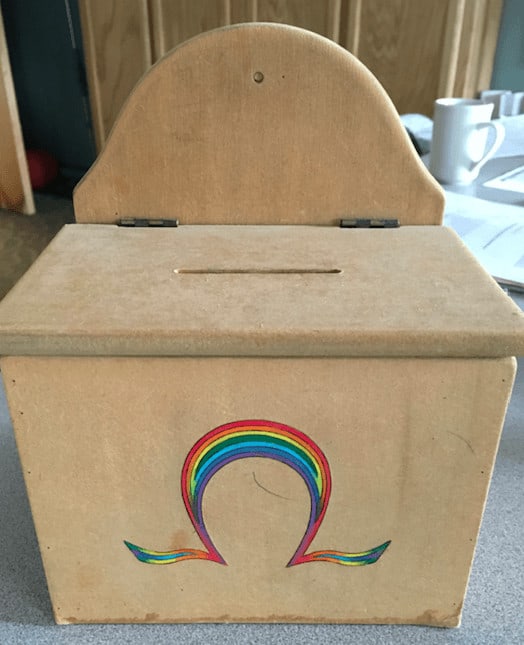
by West | May 2, 2018 | Home Page News, Rainbow Institute
Rainbow Community School had a special guest this week!
Best-selling author and Ph.D., Lisa Miller, toured our school. Lisa authored The Spiritual Child and is also the head of clinical psychology at Columbia University Teachers College. She has conducted and compiled decades of research on spiritual development in children and teens. Her research specifically quantified the effects of healthy spiritual development on mental health, resilience and thriving and provided empirical evidence that children are naturally spiritual beings. Her book also serves as a resource for parents as they navigate the important work of raising spiritual children.
Lisa is currently heading up a new project called the Collaborative for Spiritual Development. This work is aiming to develop resources for educators who wish to nurture their students’ spiritual capacities. Lisa became aware of Rainbow’s 40-year history of embracing a secular spiritual curriculum and as you learned in our Executive Director’s video, she wanted to find out more about how Rainbow is doing just that! We are hoping that her visit will yield new resources for a wide range of educators working to nurture the spiritual identities of their students.
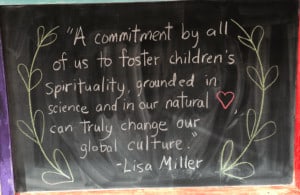
The commitment to this work is outwardly palpable among Rainbow’s staff and faculty and as a result, the spiritual curriculum is woven into the daily rhythm of each classroom.
The RCS spiritual curriculum has four primary aspects under which all its goals and objectives fall:
- Mystery and Contemplation
- Spiritual Virtues
- Ceremony and Celebration
- World Traditions.
Often, a centering practice is developed with one specific aspect in mind. Many Omega Middle School (OMS) centerings embrace theMystery and Contemplationaspect. These centerings welcome the unknown as a source of inspiration and wonder and are filled with questions, quotes or prompts that invite the students to seek deeper meaning and purpose through reflection. Just this morning, for example, Albert Einstein’s wise words were written on the whiteboard as a welcoming for each OMS student upon arrival.
“The important thing is not to stop questioning. Curiosity has its own reason for existing.”
One of the OMS classrooms has a special centering called The Philosopher’s Box. The intended purpose of this centering is to encourage this deep questioning.
To introduce this activity, ask the students what they know about the word “philosophy”, and/or if they know what the role of a philosopher is. Then share the etymology of the word “philosophy.” This word is Latin and Greek in origin and means to love knowledge: Philo=love, Sophia=knowledge. Follow by explaining that philosophy is the study of fundamental questions about the nature of existence, big ideas such as love, truth, beauty, and what it means to lead a fulfilling life.
At this point the teacher introduces the Philosopher’s Box. This is a physical box decorated with a bit of magic and whimsy or as you see fit.
Each student then writes down at least two philosophical “wonderings.” These are questions with no right or wrong answers.
Some examples for students may be:
- “Do you believe life exists on other planets?”
- “Is it important to always be 100% honest and truthful at all times (why or why not?)”
- “Do you believe it’s possible to predict the future?”
- “If you could have the abilities of one animal, which animal would you choose and why (i.e. to fly like a bird or to breath underwater like a fish)?
After giving specific examples, the students are asked to take the next few moments to reflect upon the kinds of open-ended questions they wonder about, and then place their questions in the box. From here there are many options for discussion. The teacher can pick a question at random from the box, and have students take turns answering. Or, students can pair up and discuss their answers with each other. Students and teachers can add to the box throughout the year – for example, when a good “wondering” or “what if?” question comes up during class discussion.
This centering is intended to provide a healthy and intentional space where learners can feel safe and supported as they ponder the “big questions.” Centerings like these help to bring a sense of meaning and purpose into their lives. Research suggests that having a stronger sense of purpose can make a significant difference in our lives. In fact, Lisa Miller’s research, link spiritual purpose to improved health, well-being, and a more meaningful and successful life.
Centerings like these connect our students to something greater than themselves- to something deeply spiritual.

by West | Mar 22, 2018 | Blogs, Home Page News, Rainbow Institute
An altar is commonly associated with a religious purpose. It is often a structure or space, considered sacred, on which offerings are placed and used in a rite or ritual. However, we often create altars to honor various things that aren’t necessarily associated with a religious purpose.
We make altars all the time, some intentionally, some unintentionally and others out of habit. Consider how you may arrange your collectibles, how you may display your family photos or art, or how you may plan your garden. Think about the forts or fairy homes that your kids make in the backyard or how they arrange their special artifacts or favorite toys. With these “altars” we aim to elevate, focus energy and/or bring special attention to something.
Altar creation can be a very powerful process. It provides a space to slow down and reconnect to something very personal or meaningful to you. Creating a spiritual altar can also be a physical and visible representation of an intention you may have. It may also serve as a sacred way to invite spiritual energies and questions into your life . Ultimately, altars become focal points or reminders of our inner spirit and our connection to the divine.
Altars are very much a part of the culture of Rainbow
They are found in every classroom, used each day in centering practices and are often created by the students. The elements used in each altar vary but are often reflective of the season, the theme that the class may be studying, or the message the centering practice intends to convey. Below are some classroom altars.
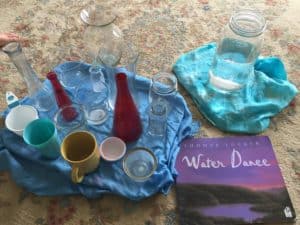
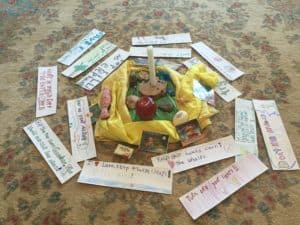
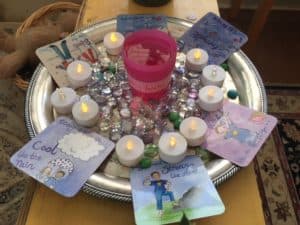
Co-creating altars
In an effort to raise money for their end of year trip, some of our students recently designed, created and sold traveling altars. Each altar provides various resources and tools that may help others to bring a centering practice into the home.
- The tablecloth serves a way to transport the altar as well as an aesthetically pleasing foundation to set up the altar.
- The candle, when lit, sets the tone for the practice and invites spirit into the room. It is also a visible reminder to celebrate the light in ourselves, others and the world around us.
- The shell demonstrates our connection to the natural world. Displaying nature artifacts bring forth the wonder and magic of the natural world and reminds us that time in nature can yield deep connection and contemplation.
- The painted rock displays a word of intention and reminds us to aim to bring positive emotions into our lives.
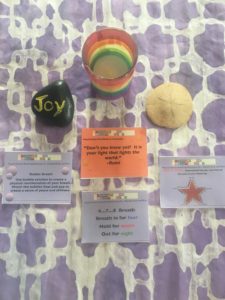
The blue cards share three different breathing techniques that help the mind and body achieve awareness, presence and peace. The orange quote card is intended to engage the reader’s mental domain by encouraging them to reflect on words of wisdom. The yellow cards highlight social conversation questions posed by the students. These cards encourage the readers to ponder big questions such as, “When and how was the universe born?” and “What happens after death?” or ask the reader to personally reflect on things like, “What type of personal do you hope/aim to be?” or What helps you to feel calm and grounded?”
How might these inform your practice?
The creators of these traveling altars were hoping that the altars would prompt centering practices within the home. The elements of each altar are simply starting points out of which family ritual, contemplative practice and spiritual development can grow.
Consider what your family or classroom altar could look like. Where might it live? What elements would you include? What question cards or breathing techniques could be added to this package? What inspirational quotes might serve your family or classroom?

by West | Mar 8, 2018 | Blogs, Home Page News, Rainbow Institute
We live in a time of uncertainty, in a world that is unpredictable and in a society that is, in some cases, changing rapidly and in others stuck. Nevertheless, our work as educators is more important now than ever.
As an organization, we aim to live our mission everyday. Some days we do so effortlessly and seamlessly. Other days we detour, stumble and struggle. Many days yield cheer and celebration, yet many yield mistakes and misunderstanding. Regardless of the outcomes, we see them ALL as an opportunity to deeply reflect, adapt and grow.
We are an organization on a transformational journey informed by these opportunities, guided by our hearts and our spirits and fueled by our mission.
We develop accomplished, confident, and creative learners who are prepared to be compassionate leaders in building a socially just, spiritually connected, and environmentally sustainable world.
As a teacher, to live this mission means that you are intentional about circling back to it and that you are willing to hold a mirror up to your classroom culture and programming. These opportunities often show up in unexpected ways but, if you are waiting with that mirror, some amazing learning can happen.
Spirit Week at RCS
Next week is Spirit Week at RCS. This week fills our school classrooms, campus and culture with fellowship and fun. It invites costumes, and creativity while building community. As Student Council began to flesh out the daily Spirit Week themes, they stumbled on an opportunity- a real teachable moment. In an effort to give this teachable moment greater context, our Equity Director wrote a letter to our families.
“In the interest of our ongoing efforts to be more mindful of equity, we are eliminating ‘Crazy Hair Day’ from our Spirit Week schedule. There are a couple of concerns about this practice. To begin with, the regular and loose use of the term ‘crazy’ is disrespectful to those who live and struggle with mental illness. Even if we are innocently using the term to refer to something that is different and/or weird, we need to ask ourselves if that’s really the message we want to send about hair. While there are some really cute and elaborate ideas out there for ‘Crazy Hair Day’, all too often, the expressions that come out of this Spirit Week practice are styles that closely resemble (intentionally or not) actual cultural and ethnic hairstyles. The suggestion that those styles are crazy or weird is offensive. Would it be ‘crazy hair’ if a child with curly hair came to school with their hair straightened for the day?
Here at Rainbow, equity is a practice. So we’re using this as a teachable moment for our students. Some of your teachers are taking this time to talk about culture and cultural practices, and concepts of ‘different’ vs. ‘weird’. If you want to continue these discussions at home and feel like you could use some supportive material, please reach out to our Equity Director. In addition, HERE is a link to a very thoughtful post from a parent about ‘Crazy Hair Day’.
Teachable Moments
This topic became inspiration for a 4th grade centering practice. Centering began when the class found stillness and silence. The candle was then lit for “safety” and the teacher began, “Yesterday we talked about physical safety and today we will talk about emotional safety.”
Susie, the teacher, followed by asking for a volunteer to read Rainbow’s mission statement. She then asked, “Where does this come from?” The kids responded, “The School!” She explained that this was our mission statement and ultimately our hope for each action, every day.
Around the altar were the words Ethnic and Culture. The teacher asked the students what these words meant to them. As a group, the kids built collaborative definitions and came to some common understandings of each word. Susie then revealed a final sheet of paper with the phrase ‘Crazy Hair Day’ written on it and began touching on some of the concepts that were explained in the above letter. Finally, she began showing the group images of hairstyles that were based on the cultural or ethnic backgrounds of the people pictured.
These images were passed around the circle in silence. The students were asked to simply use their powers of observation, acknowledge any reactions, consider the terms ‘ethnic’ and ‘culture’ while making mental notes as they cycled through each image.
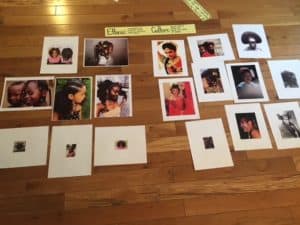
In closing, Susie asked to kids to try to weave all the centering elements together and identify the message that she was trying to share with them. One child responded,”By saying something or someone is crazy, you are judging them.” Another student said, “The things that may be fun for me, like crazy hair day, could really hurt someone else. This might be the way they do things and if you make fun of them, it could hurt their feelings.” Another child said, “What you might consider crazy hair for you may be they way that others wear their hair everyday.” One noted that, “Yesterday we talked about how some cultures greet people in different ways we should think about how some people wear their hair in different ways.” Susie ended with a simple statement about how we, for the last several years have been hosting Crazy Hair Day and upon reflection and insight we have realized that this choice does not fit within our mission statement. As a community, we decided to let go of it because we strive for emotional safety for all.
Now what?
Consider your personal mission statement or that of your school or organization. Reflect…
What are you doing to successfully achieve this mission? Celebrate that!
Now consider, how can those mission statement words be better represented with action?
What changes to your direct practice can open up pathways of learning for you, your family and/or your students?

by West | Feb 23, 2018 | Blogs, Home Page News, Rainbow Institute
Darkness cannot drive out darkness, only light can do that.
Hate cannot drive out hate, only love can do that. –Martin Luther King Jr.
Rainbow Community School is governed by light and founded on love.
Connection to oneself, others, the natural world and the spiritual is at the heart of what we do. We are a school founded on the holistic development of each child. The essence of each child is seen, heard, celebrated and challenged. There is always a circle of light and of love around each child.
We educate for non-violence. We aim to equip children with compassion, empathy, resilience and respect. We teach compassionate communication, positive discipline and healthy conflict resolution. We provide a therapeutic response to education. We are trauma informed. We do this because we see every child, we hear each child, we celebrate and challenge every child. We love each child.
We do this because the world needs schools founded on love, the world needs teachers who see and can support the whole child, the world needs empathetic and compassionate children, the world needs love- now more than ever.
Valentine’s Day is a symbolic day of love but unfortunately, was tragic day for many last week. The events that happened in Parkland, Florida are sobering; it is the 18th school shooting already this year. We mourn for those families and that community, and strive to protect our own, perhaps turning inward to consider how we got to this point and where to go from here.
Keeping all children safe is always the highest priority and most important job of each employee at Rainbow.
This is our first focus- from informing and advising the community of school-wide health concerns to implementing things such as a safe school plan, lock downs and evacuations. These measures are put in to place out of love.
Even still, Rainbow Community School strives to provide an additional layer of protection. This layer is not necessarily visible, but is one that stays with each child well after they graduate. Our school aims to foster healthy relationships, nourish emotional health and well-being, make learning meaningful, support ritual and rites of passage and most of all, cultivate a spiritual identity rooted in purpose.
Contemplation, reflection, deep discussion, heart centered connection, healthy risk taking, simple play, time in nature, communal support and celebration are among the many elements that are woven together to provide these protections.
As we wade through the pain, anger and confusion of each moment of crises, we are left with many questions and become increasingly conscious about protecting all children.
The NRA says, “guns don’t kill people, people kill people,” but have the members of the NRA or the politicians engineering policy ever stopped and asked…why? Yes- changing gun regulation, policy and law is certainly a step towards ensuring our safety, however, it does not get at the root of the issue. It does not consider how these children end up choosing violence or what society has done or not done to fail them. This is where educational policy, programming, school culture and support come into play. This is where love can make the biggest impact.
How do we support children on their educational journey so they don’t turn to violence?
The answer lies in developing in not only the social, emotional but the spiritual domain. The healthier they are in these affective areas that more protection they have. In The Spiritual Child, psychologist Lisa Miller illustrates a clear link between spirituality and mental health. Her research shows that children who have a positive, active relationship to spirituality are 40% less likely to use and abuse substances, 60% less likely to be depressed as teenagers and are 80% less likely to have dangerous or unprotected sex. Ultimately children are more protected against risky behavior when their education, growth and development is rooted in their own spirituality. The research speaks for itself. This is what we offer kids. This is how we support them. This is how we protect them. This is how we love them.

by West | Jan 30, 2018 | Blogs, Home Page News, Rainbow Institute
Teaching thematically
Integrated thematic units are considered best practice at Rainbow. Thematic lessons are layered in both discipline and in learning domain. Layering in this way encourages theme engagement from many angles and through many lenses. This allows a student to connect with the material through their preferred learning domain while nurturing a lasting relationship with the material. For example, what is taught in science may be incorporated into the social studies topic, written about in language arts, or read through literature. This method nurtures learning that is both circular and interconnected.
First grade is currently studying Africa. A recent centering lesson was layered in mindfulness and contemplative ritual, kinesthetic learning, teamwork and critical thinking. It was also rooted in the geography, natural history and culture of Africa.
The centering begins, like all RCS centerings, with a prompt to, “still your minds, bodies and voices and at the sound of each chime, take three audible deep breaths.” Josie, the teacher, then asked the class Mindful Mediation Leader to offer a word or intention that we can hold in our hearts. “African animals” was offered and Josie struck a match and said, “may we honor African animals as our teachers.”
These rituals served to shift the class energy inward resulting in a moment of silence and stillness. Josie then showed a picture of the Efé children of the Zaire, Ituri Forest and asked contemplative questions.
“What do you see, think and wonder about this picture?”

The Osani Circle Game
Josie explained that these children were playing a game called The Osani Circle Game. This prompted a conversation about circles. She stated that circles and cycles are seen everywhere. They are symbols of connection and wholeness. They are considered incredibly strong. Josie asked, “Can we name some circles or cycles?”
She went on to describe that the players of the game harness the strength of the circle by physically creating a circle with their feet and bodies. Each person then takes a turn naming a circular object, concepts or cycles such as apples, belly buttons, pies, time, the water cycle, butterfly cycle, the seasons. The goal being to hold the circle throughout the game while, without hesitation, naming circular objects.
In an effort to anchor the kids in teamwork, set the tone for the game and harness the power of the circle, Josie started by sending a “squeeze around the circle.” She then led them to create a human mandala. Finally, she guided them through a closed-eyed medication that allowed them to picture the circles all around us.
The kids named things like the butterfly cycle, the Sun, the belly of a bear, our noses, etc… More importantly they had fun while learning in a rich and integrated way- from learning about Efé children, to physically and collaboratively recreating the circle, to thinking fast and maintaining concentration throughout the game.
However, it was the unwritten curriculum that spoke volumes- the wisdom of the circle. The circle as a powerful symbol has been referred to since the beginning of time. It is celebrated in many religions and cultures as divine. It holds archetypal influence in story and myth and is represented by so many natural phenomena. Consider the Tibetan mandala, the Native American medicine wheel, the wedding ring, the Hero’s Journey, the Sun or Moon cycle. This centering ended with a closing verse that integrated some important circular objects found in our lives.
Informing your practice
If children are deeply and comprehensively connecting to the Circle, then they are more likely to return to it later in life as a teacher or guide, a tool, a strategy, an anchor or a healing source. I ask you to consider how circles show up in your life, to pay attention to their influence, and to invite them in as teachers.




















